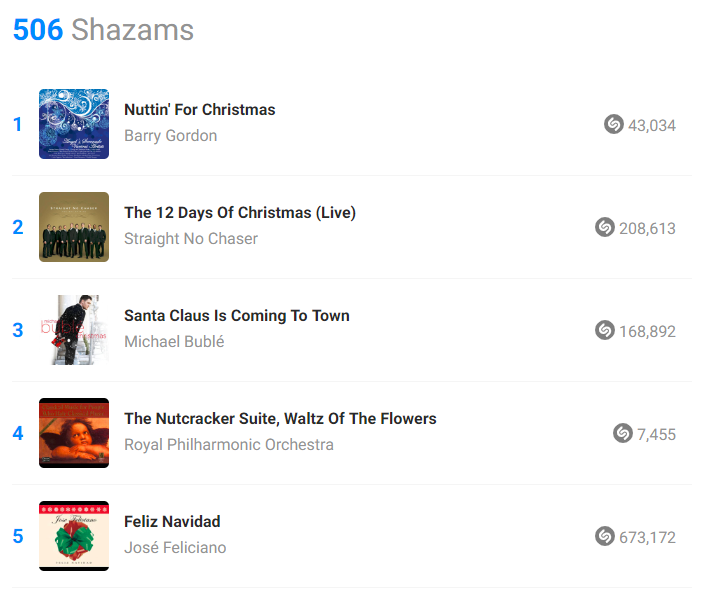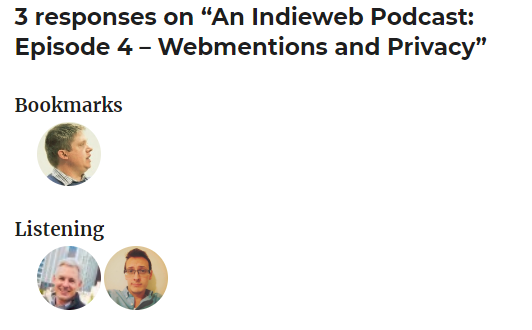scrobble
🎧
This article is a stub. You can help the IndieWeb wiki by expanding it.
scrobbling is the act of passively publishing scrobbles.
Origin
The term "scrobble" comes from Last.fm's software, Audioscrobbler.
IndieWeb Examples
Marty McGuire
 Marty McGuire imports his podcast listens from the extended OPML supplied by Overcast. Listen posts are microformats2 h-entry posts with a listen-of property containing an h-cite pointing to the podcast episode URL, show metadata, and an embedded audio player, if available. Listen posts don't appear in Marty's main feed.
Marty McGuire imports his podcast listens from the extended OPML supplied by Overcast. Listen posts are microformats2 h-entry posts with a listen-of property containing an h-cite pointing to the podcast episode URL, show metadata, and an embedded audio player, if available. Listen posts don't appear in Marty's main feed.
- Details and announcement: https://martymcgui.re/2019/02/19/site-updates-listens-and-photos-pages/
- Dedicated listen page / feed: https://martymcgui.re/listens/
- Example listen permalink: https://martymcgui.re/2020/11/27/listened-to-62-automation-fun-with-alex-cox/
Acegiak
acegiak PESOS imports her Last.fm listens to her wordpress blog using the plugin WP_LastFmScrape. they are published as listens under the Post_Kinds_Plugin taxonomy.
tommorris.org
tommorris publishes links to DJ sets (mostly from Mixcloud) and some songs (mostly from Spotify) manually (and actively rather than passively) and tags them currently playing. May start PESOS-ing from Mixcloud or using a bookmarklet.
davidpea.ch
davidpeach has written an article on how he uses a bookmarklet to share albums listened to on Google Play all access to his own site. Semi-automated PESOS from google play music.
He also displays all of his tracked listens on his website at https://web.archive.org/web/20160314183525/https://davidpea.ch/listens
Eddie Hinkle
 Eddie Hinkle has been tracking listen posts of podcasts that he listens to since 2017-04-01. They are marked up as an h-entry with an experimental u-listen-of property as an h-cite and a p-summary plain-text description and an experimental p-status with the value of "finished" signifying that I have listened to it. I also occasionally post them with p-status=planned to signify that I want to listen to it. The u-listen-of/h-cite property contains a p-name (The name of the podcast post), u-photo (the cover art of the podcast), u-audio (the embeddable audio file of the podcast) and u-url.
Eddie Hinkle has been tracking listen posts of podcasts that he listens to since 2017-04-01. They are marked up as an h-entry with an experimental u-listen-of property as an h-cite and a p-summary plain-text description and an experimental p-status with the value of "finished" signifying that I have listened to it. I also occasionally post them with p-status=planned to signify that I want to listen to it. The u-listen-of/h-cite property contains a p-name (The name of the podcast post), u-photo (the cover art of the podcast), u-audio (the embeddable audio file of the podcast) and u-url.
Chris Aldrich
 Chris Aldrich has been posting listens since 2016-12-06 using the Post Kinds Plugin for WordPress which wraps the posts with a listen-of microformat. When audio, particularly for podcasts, is available he includes the audio file along with html
Chris Aldrich has been posting listens since 2016-12-06 using the Post Kinds Plugin for WordPress which wraps the posts with a listen-of microformat. When audio, particularly for podcasts, is available he includes the audio file along with html audio tags marked up with u-audio. These posts can be found at https://boffosocko.com/kind/listen/ and the feed for these posts at https://boffosocko.com/kind/listen/feed can be subscribed to like a traditional podcast. Because this feed is meant more to help other's discovery of content, he calls this non-traditional podcast a "faux-cast". More details here.
Jeremy Cherfas
 Jeremy Cherfas started tracking podcast listens around 2019-03-24. He uses a PHP script based on
Jeremy Cherfas started tracking podcast listens around 2019-03-24. He uses a PHP script based on  Jonathan LaCour's Python script to extract the data from an extended OPML supplied by Overcast. Each post is marked with u-listen-of on the link supplied by OverCast. The hope is to make this point to the episode url instead. Listen posts are collected at https://jeremycherfas.net/stream
Jonathan LaCour's Python script to extract the data from an extended OPML supplied by Overcast. Each post is marked with u-listen-of on the link supplied by OverCast. The hope is to make this point to the episode url instead. Listen posts are collected at https://jeremycherfas.net/stream
Xavier Roy
Xavier Roy indicated in this post how he maintains his listen posts using the Post Kinds plugin.
Jeffrey Zeldman
While not technically listens or scrobbles, as early as August 2004 Jeffrey Zeldman was offering "Freebies" of music linked to iTunes in his sidebar. (example: https://web.archive.org/web/20041018082437/http://www.zeldman.com:80/) This turned into a "Holitunes" section of his sidebar in late 2004 and then much later a "Listen" section. Presumably this was music he either listened to or was tacitly recommending and is a more manual-based historic precursor to scrobbling or listen post functionality.
Jamie Tanna
 Jamie Tanna retrospectively posts his Year in Review of music, based on most listened to songs and artists, i.e. https://www.jvt.me/music-in-review/2021/
Jamie Tanna retrospectively posts his Year in Review of music, based on most listened to songs and artists, i.e. https://www.jvt.me/music-in-review/2021/
Jamie also posts listens of i.e. podcasts at https://www.jvt.me/kind/listens/
benji
![]() benji has tested adding
benji has tested adding listen-of posts on his site. These are experimental.
- Feed: https://benji.dog/listens
- Example listen post: https://www.benji.dog/listen/1731566022-songs-of-a-lost-world-2024/
- Posts are created using Sparkles which uses Songlink and iTunes API to search and fetch artist, album, and song details.
Previous Examples
Michael Owens
Michael Owens imported all 76,000 of his past Last.fm listens to his site. He can post them manually to his site as well as PESOS them from Last.fm. Example:
- https://mowens.com/data/2014/10/16/1/take-me-to-church-album-version (link is dead (when?), needs Internet Archive version)
Details:
- Musicbrainz ID. Each of the data elements has a p-* with the Musicbrainz ID of the various Tracks and Albums where it's available.
- Album images.
It annoyed me that Last.fm served images without HTTPS, so I cached the imagery for every track. I need to run a checksum comparison of images to remove duplicate files at some point.
Silos
Last.fm
Last.fm was one of the first silos to have listen posts. The term "scrobble" comes from their software, Audioscrobbler.
Shazam
Shazam is a music (and television) bookmarking and discovery silo service that operates by listening to ambient sound via an app to identify the content to enable both identification and bookmarking. It creates a private running list of listen posts with some scant details including song titles, artists and album art. These posts include inline audio samples and the ability to share to other silos like Facebook, Twitter, and Google+. They do not include date or time stamps though there is a Shazam integration with IFTTT which can allow one to extract more data from the Shazam system to import into one's website by a variety of methods.
This is my Jam
This Is My Jam (abbreviation TIMJ) was a silo for sharing music you are enjoying, commonly called "jams". While subtly different from listen posts, jams are ostensibly very similar in form and can provide useful UI examples.
SoundHound
SoundHound is a music discovery app similar to Shazam. It creates listen posts with date and timestamps as well as locations, but doesn't provide much in the way of data export from its mobile-only app.
Tools
Semantic Linkbacks WordPress Plugin
The Semantic Linkbacks WordPress plugin consumes the listen-of microformat to display a separate facepile of people listening. See #Displaying_Listen_Webmentions below.
Open Source
Libre.fm and GNU FM
There exists https://libre.fm which uses GNU FM. Once could conceivably run this on their own site.
WordPress Audioscrobbler server
The WordPress Audioscrobbler plugin can receive and store v1.2 scrobble requests as custom post type.
Brainstorming
Michael L. Douglas maintains a wiki on which he keeps a weekly scrobble list of songs he's listened to which looks a lot like the old school printed Billboard Hot 100 lists. This is certainly an interesting way of displaying scrobbles.
IndieWeb Scrobbling
Creating an IndieWeb implementation of a scrobbling server or pass-through relay would free data about one's music listening activity and history from the Last.fm silo. One would scrobble tracks to their own personal server before syndicating the activity to other social sites like Last.fm. All of the scrobbling activity would be archived in a database on one's personal web server. A simple implementation need only implement the basic functionality present in the Last.fm API such that existing Last.fm client software could be used with minimal modification.
Displaying Listen Webmentions
Listen/scrobble posts can send webmentions to the original content potentially with the experimental listen-of microformat. In the case of scrobbles of podcasts, these webmentions could be displayed as Listens which would provide the canonical copy of the podcast some indicator of its popularity. It is tremendously difficult to obtain data on the actual number of listens within most of the podcast community and typically a fraction of the number of downloads must be used as an indicator of the actual listenership. Being able to display actual listens could potentially be a boon to the podcasting market, particularly with respect to advertising.
On 2018-04-08 David Shanske added the ability for the Semantic Linkbacks plugin to parse and display listen posts to better support his podcast with
 Chris Aldrich. As a result those who post listens with the listen-of microformat and send webmentions will allow the display listens on his podcast posts. The example UI appears as follows:
Chris Aldrich. As a result those who post listens with the listen-of microformat and send webmentions will allow the display listens on his podcast posts. The example UI appears as follows:
Ideas for advanced features
Scrobbling activity could be syndicated in other formats (i.e. Activity Streams), or published in another form altogether such as a tweet or status update.
Scrobbling activity could be filtered prior to syndication. For example, before publishing a track, the software could first check the artist and/or track name is not present in a list of "guilty pleasures."
See Also
- posts
- audio
- passive
- metrics
- podcast
- http://www.audioscrobbler.net/development/protocol/
- https://www.npr.org/sections/npr-extra/2018/12/11/675250553/remote-audio-data-is-here
- With RAD, podcasters can finally learn who's listening
- 2019-05-15 NYT: Why Play a Music CD? ‘No Ads, No Privacy Terrors, No Algorithms’
- setlist
- http://musicontology.com/specification/ could be used to help with marking up listen posts
- Brainstorming: another way to implement scrobbling vinyl plays would be a camera pointed down at your turntable. then it could recognize the record, get the track listing for that side, detect rotation, track needle position, and scrobble exactly when a track finishes
- jam



